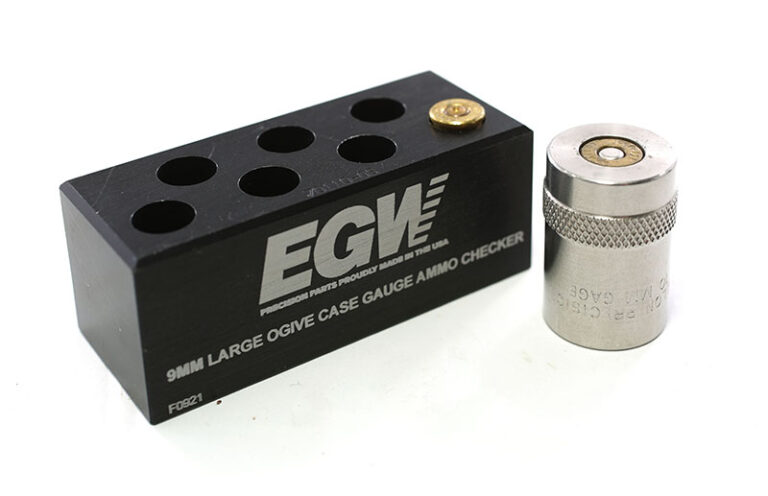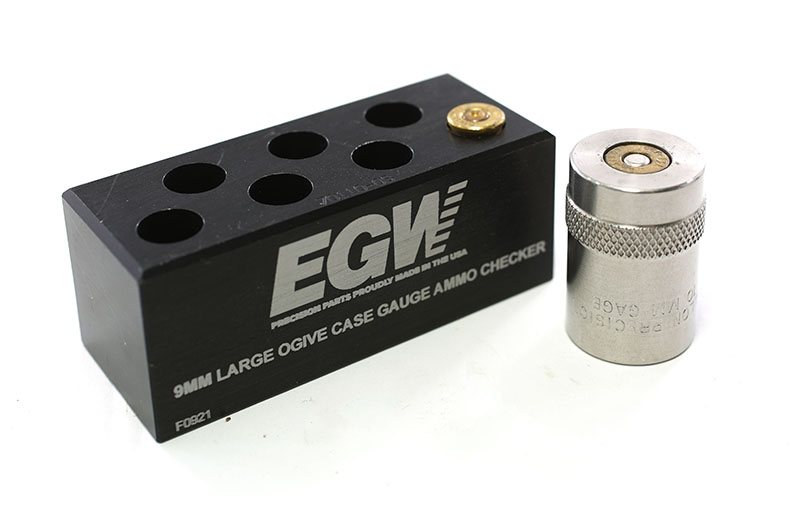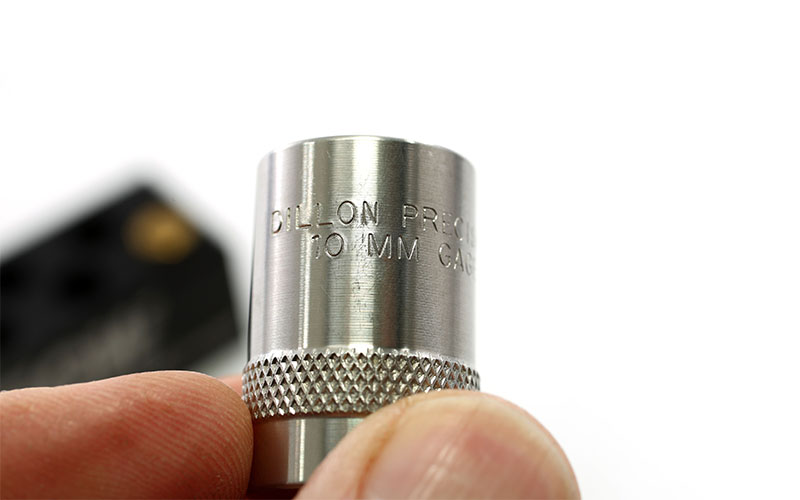
A simple case gauge or case-check tool will drastically reduce ammo-related stoppages.
Some mistakes you make only once.
If you want to practice more, you reload your ammo. If you want the best-possible ammo for a given competition, you reload your ammo. And, sooner or later, when vacuuming up the range, you’ll pick up a piece of brass that won’t chamber after you’ve gone to the trouble of cleaning, sizing, priming and loading it. Usually that happens in a match. Murphy’s Law and such.
That night you’ll be searching out case gauges online. Save yourself the match hassle and do it now. Case checkers are simple—a steel or aluminum block with the chamber reamed to absolute minimum chamber dimensions. These are used in rifle reloading to check the “shoulder bump,” the setting back of the shoulder you check so you have a proper headspacing setup in your reloading. You use them a bit differently for handguns.

After you’ve sorted and cleaned your brass (and checked for cracked ones as well), load your ammo. Once you have a batch or several loaded, simply spend some boring alone time dropping each loaded round into the case gauge. Then, turn the gauge over to let it fall out. If this is your match ammo, you’d be wise to also look at and touch the primer on each one to make sure it’s properly seated (not sideways, upside down or crushed) … and below flush.
If a round won’t drop completely of its own weight, it fails. If it won’t drop out of its own weight when you turn the case gauge over, it fails. Set the fails aside.
What passes is your good ammo, and you can practice or compete with it with complete confidence. What do you do with the fails? Learn. First, inspect them. Do they appear normal? Good. Keep them. The ones where the bullet caught the case mouth and crumpled the case, slipped sideways and did the same, or other case-mangling errors are discards. You might not be belling the empties enough, or you might be ham-handed in setting bullets or pulling the press handle.

Learn what you’re doing wrong and correct it.
When you practice, take along the box of fails. If you’ve been paying attention, they won’t be many, and they’ll probably be cases that are slightly swelled at the base and won’t pass case-check. Shoot your normal practice session.
Now, pick up all your brass (and whatever else you’re in the habit of hoovering up at the gun club). Load a magazine with the fails and shoot them. If they all work, then you know your case gauge is more discriminating than your chamber. So, unless a checked round sticks halfway out of the case-checker, it’s probably still good to go. (Keep them as practice rounds anyway, not as match rounds.)

If more than just one or two fail in your handgun, then you know the checker and your chamber are in close agreement, and anything that fails the case gauge is “end of practice” ammo only. In that case, you now pick up those empties and deposit them in the trash. You’re performing a public service to fellow club members by getting oversized brass out of circulation.
Where does this brass come from? Some is just bad brass. A quick search will uncover the names and headstamps of brass to avoid. But some of it comes from one of your own club members, who either has a grossly oversized chamber or is running his pressures too high and over-expanding brass.
Don’t let his situation become your problem. Check your ammo and make your practice good, not just malfunction-clearing afternoons.
Editor's Note: This article originally appeared in the May 2022 issue of Gun Digest the Magazine.
More On Reloading:
- Tips For Reloading the .30-06 Springfield
- Loving Your Luger: Reloading the 9mm Luger
- Handloading: Tips For Reloading The 7mm Rem Mag
- How To: Tips For Reloading the .223 Remington
- Reloading Bench: The Inside On Reloading For The .30-30 Winchester

Next Step: Get your FREE Printable Target Pack
Enhance your shooting precision with our 62 MOA Targets, perfect for rifles and handguns. Crafted in collaboration with Storm Tactical for accuracy and versatility.
Subscribe to the Gun Digest email newsletter and get your downloadable target pack sent straight to your inbox. Stay updated with the latest firearms info in the industry.

![Best Concealed Carry Guns In 2025 [Field Tested] Wilson Combat EDC X9S 1](https://gundigest.com/wp-content/uploads/Wilson-Combat-EDC-X9S-1-324x160.jpg)


![Best 9mm Carbine: Affordable PCCs [Tested] Ruger Carbine Shooting](https://gundigest.com/wp-content/uploads/Ruger-Carbine-Shooting-100x70.jpg)
![Best AR-15: Top Options Available Today [Field Tested] Harrington and Richardson PSA XM177E2 feature](https://gundigest.com/wp-content/uploads/Harrington-and-Richardson-PSA-XM177E2-feature-100x70.jpg)

“Stoppage” is one matter, but another is safety. I have run across split 9mm cases that were almost invisible to the naked eye and yet after loading them they would not pass a gauge. Also if one used a quality 100 ammo inspection of primers and the like is invaluable. With Glock bulge happening on a 9mm tapered case it is not alway a given that they will fully chamber when reloaded.
I bought the Dillon stainless steel .223 gauge due to case length. When I first started reloading .223 ammo, I would sometime get a fired case stuck in the chamber and it played hell getting it out. My RCBS sizing die is great for forming the correct bottle neck size. With this Dillon gauge I can tell immediately what cases need to be trimmed without measuring every one with calipers. Well worth the money.